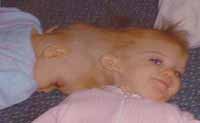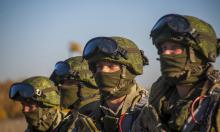Doctors take step toward eventual separation of conjoined twins
Doctors who have been preparing for a high-risk series of surgeries to separate 3-year-old twins joined at the head plan to complete an early operation in the months-long procedure Wednesday.

Doctors hope to separate Tatiana and Anastasia Dogaru, born in Rome, through several surgeries over about six months. Without separation, the twins run the risk of dying in early childhood.
In the daylong procedure Wednesday, surgeons have said they will begin at the girls' scalps and slowly make a wedge where the twins share their skulls. A piece of bone to be removed will be temporarily reinserted.
The procedure will give neurosurgeons their first real glimpse of the girls' brains. The medical team had been practicing on a model designed from images.
How much separation is accomplished depends on the complexity of blood vessels, tissue and bone connections. A hospital spokeswoman said it may be Friday before doctors will be able to provide a medical update.
The girls' parents, the Rev. Alin Dogaru, a Byzantine Catholic priest, and Claudia Dogaru, both 31 and from Romania, have said they view the medical procedures as the best hope for the two girls. They arrived in Cleveland on April 6 after 2 1/2 years in Dallas.
Twins born joined at the head - referred to as craniopagus twins - are rare, occurring in about one in 2.5 million births. The top of Tatiana's head is attached to the back of Anastasia's, and they have never been able to look directly at each other.
Last month, doctors at University Hospitals' Rainbow Babies & Children's Hospital succeeded in establishing independent blood flow in the twins by inserting a small coils into veins in their brains. That was viewed as a prerequisite for separation surgery.
Dr. Alan Cohen, chief of pediatric neurosurgery, and Dr. Arun Gosain, chief of pediatric plastic surgery, were confident a team of up to 50 specialists was ready for the Wednesday operation. Surgeons spent Saturday and Monday in practice sessions.
They met again Tuesday to make sure preparation was complete but were unavailable for further comment, a hospital spokeswoman said.
Bleeding in these procedures is a major risk. Other potential complications include infection, stroke and a build up of fluid in the brain, doctors say.
Subscribe to Pravda.Ru Telegram channel, Facebook, RSS!


